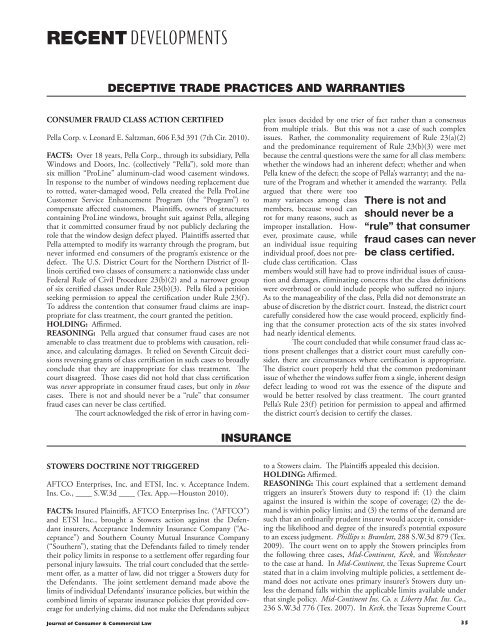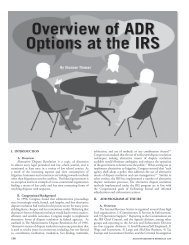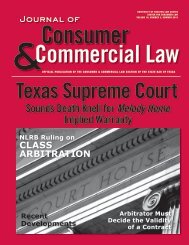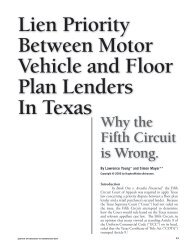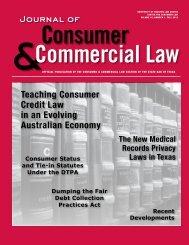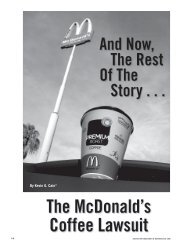Insurance - Journal of Comsumer & Commercial Law
Insurance - Journal of Comsumer & Commercial Law
Insurance - Journal of Comsumer & Commercial Law
Create successful ePaper yourself
Turn your PDF publications into a flip-book with our unique Google optimized e-Paper software.
RECENT DEVELOPMENTS<br />
DECEPTIVE TRADE PRACTICES AND WARRANTIES<br />
CONSUMER FRAUD CLASS ACTION CERTIFIED<br />
Pella Corp. v. Leonard E. Saltzman, 606 F.3d 391 (7th Cir. 2010).<br />
FACTS: Over 18 years, Pella Corp., through its subsidiary, Pella<br />
Windows and Doors, Inc. (collectively “Pella”), sold more than<br />
six million “ProLine” aluminum-clad wood casement windows.<br />
In response to the number <strong>of</strong> windows needing replacement due<br />
to rotted, water-damaged wood, Pella created the Pella ProLine<br />
Customer Service Enhancement Program (the “Program”) to<br />
compensate affected customers. Plaintiffs, owners <strong>of</strong> structures<br />
containing ProLine windows, brought suit against Pella, alleging<br />
that it committed consumer fraud by not publicly declaring the<br />
role that the window design defect played. Plaintiffs asserted that<br />
Pella attempted to modify its warranty through the program, but<br />
never informed end consumers <strong>of</strong> the program’s existence or the<br />
defect. The U.S. District Court for the Northern District <strong>of</strong> Illinois<br />
certified two classes <strong>of</strong> consumers: a nationwide class under<br />
Federal Rule <strong>of</strong> Civil Procedure 23(b)(2) and a narrower group<br />
<strong>of</strong> six certified classes under Rule 23(b)(3). Pella filed a petition<br />
seeking permission to appeal the certification under Rule 23(f).<br />
To address the contention that consumer fraud claims are inappropriate<br />
for class treatment, the court granted the petition.<br />
HOLDING: Affirmed.<br />
REASONING: Pella argued that consumer fraud cases are not<br />
amenable to class treatment due to problems with causation, reliance,<br />
and calculating damages. It relied on Seventh Circuit decisions<br />
reversing grants <strong>of</strong> class certification in such cases to broadly<br />
conclude that they are inappropriate for class treatment. The<br />
court disagreed. Those cases did not hold that class certification<br />
was never appropriate in consumer fraud cases, but only in those<br />
cases. There is not and should never be a “rule” that consumer<br />
fraud cases can never be class certified.<br />
The court acknowledged the risk <strong>of</strong> error in having complex<br />
issues decided by one trier <strong>of</strong> fact rather than a consensus<br />
from multiple trials. But this was not a case <strong>of</strong> such complex<br />
issues. Rather, the commonality requirement <strong>of</strong> Rule 23(a)(2)<br />
and the predominance requirement <strong>of</strong> Rule 23(b)(3) were met<br />
because the central questions were the same for all class members:<br />
whether the windows had an inherent defect; whether and when<br />
Pella knew <strong>of</strong> the defect; the scope <strong>of</strong> Pella’s warranty; and the nature<br />
<strong>of</strong> the Program and whether it amended the warranty. Pella<br />
argued that there were too<br />
many variances among class<br />
members, because wood can<br />
rot for many reasons, such as<br />
improper installation. However,<br />
proximate cause, while<br />
an individual issue requiring<br />
individual pro<strong>of</strong>, does not preclude<br />
class certification. Class<br />
There is not and<br />
should never be a<br />
“rule” that consumer<br />
fraud cases can never<br />
be class certified.<br />
members would still have had to prove individual issues <strong>of</strong> causation<br />
and damages, eliminating concerns that the class definitions<br />
were overbroad or could include people who suffered no injury.<br />
As to the manageability <strong>of</strong> the class, Pella did not demonstrate an<br />
abuse <strong>of</strong> discretion by the district court. Instead, the district court<br />
carefully considered how the case would proceed, explicitly finding<br />
that the consumer protection acts <strong>of</strong> the six states involved<br />
had nearly identical elements.<br />
The court concluded that while consumer fraud class actions<br />
present challenges that a district court must carefully consider,<br />
there are circumstances where certification is appropriate.<br />
The district court properly held that the common predominant<br />
issue <strong>of</strong> whether the windows suffer from a single, inherent design<br />
defect leading to wood rot was the essence <strong>of</strong> the dispute and<br />
would be better resolved by class treatment. The court granted<br />
Pella’s Rule 23(f) petition for permission to appeal and affirmed<br />
the district court’s decision to certify the classes.<br />
INSURANCE<br />
STOWERS DOCTRINE NOT TRIGGERED<br />
AFTCO Enterprises, Inc. and ETSI, Inc. v. Acceptance Indem.<br />
Ins. Co., ____ S.W.3d ____ (Tex. App.—Houston 2010).<br />
FACTS: Insured Plaintiffs, AFTCO Enterprises Inc. (“AFTCO”)<br />
and ETSI Inc., brought a Stowers action against the Defendant<br />
insurers, Acceptance Indemnity <strong>Insurance</strong> Company (“Acceptance”)<br />
and Southern County Mutual <strong>Insurance</strong> Company<br />
(“Southern”), stating that the Defendants failed to timely tender<br />
their policy limits in response to a settlement <strong>of</strong>fer regarding four<br />
personal injury lawsuits. The trial court concluded that the settlement<br />
<strong>of</strong>fer, as a matter <strong>of</strong> law, did not trigger a Stowers duty for<br />
the Defendants. The joint settlement demand made above the<br />
limits <strong>of</strong> individual Defendants’ insurance policies, but within the<br />
combined limits <strong>of</strong> separate insurance policies that provided coverage<br />
for underlying claims, did not make the Defendants subject<br />
to a Stowers claim. The Plaintiffs appealed this decision.<br />
HOLDING: Affirmed.<br />
REASONING: This court explained that a settlement demand<br />
triggers an insurer’s Stowers duty to respond if: (1) the claim<br />
against the insured is within the scope <strong>of</strong> coverage; (2) the demand<br />
is within policy limits; and (3) the terms <strong>of</strong> the demand are<br />
such that an ordinarily prudent insurer would accept it, considering<br />
the likelihood and degree <strong>of</strong> the insured’s potential exposure<br />
to an excess judgment. Phillips v. Bramlett, 288 S.W.3d 879 (Tex.<br />
2009). The court went on to apply the Stowers principles from<br />
the following three cases, Mid-Continent, Keck, and Westchester<br />
to the case at hand. In Mid-Continent, the Texas Supreme Court<br />
stated that in a claim involving multiple policies, a settlement demand<br />
does not activate ones primary insurer’s Stowers duty unless<br />
the demand falls within the applicable limits available under<br />
that single policy. Mid-Continent Ins. Co. v. Liberty Mut. Ins. Co.,<br />
236 S.W.3d 776 (Tex. 2007). In Keck, the Texas Supreme Court<br />
<strong>Journal</strong> <strong>of</strong> Consumer & <strong>Commercial</strong> <strong>Law</strong> 35
RECENT DEVELOPMENTS<br />
stated that the Stowers duty does not arise for an excess insurer<br />
until the primary carrier has tendered its limits. Keck v. Nat’l<br />
Union Fire Ins. Co., 20 S.W.3d 692 (Tex 2000). In Westchester,<br />
this court concluded that an excess insurer was not entitled to<br />
equitable subrogation against a primary insurer from breach <strong>of</strong><br />
its Stowers duty when the initial settlement demand exceeded the<br />
limits <strong>of</strong> the primary policy. Westchester Fire Ins. Co. v. American<br />
Contractors Ins. Co. Risk Retention Group, 1 S.W.3d 874 (Tex.<br />
App. Houston 1st Dist. 1999).<br />
In reviewing the claim against Southern, this court stated<br />
the settlement <strong>of</strong>fer did not state a release <strong>of</strong> claims against the<br />
Plaintiffs under a particular policy and the settlement demand<br />
was a sum that exceeded Southern policy’s limits and was an aggregation<br />
<strong>of</strong> multiple policies. See Mid-Continent Ins. Co., 236<br />
S.W.3d at 776. Thus, the trial court correctly granted summary<br />
judgment in favor <strong>of</strong> Southern. In reviewing the claim against<br />
Acceptance, the court stated that the primary carrier never tendered<br />
its policy limits and the trial court also correctly granted<br />
summary judgment in favor <strong>of</strong> Acceptance in accordance to the<br />
rulings in Keck and Westchester. So, the court concluded that the<br />
settlement demands by the personal injury plaintiffs never triggered<br />
the insurers’ Stowers duties. The settlement terms required<br />
funding from multiple insurers, and no single insurer could fund<br />
the settlement within the limits that applied under its particular<br />
policy.<br />
TEXAS STANDARD HOMEOWNER’S POLICY COVERS<br />
MOLD DAMAGE TO PERSONAL PROPERTY BUT NOT<br />
DWELLING<br />
State Farm Lloyds and Erin Strachan v. Wanda M. Page, 315<br />
S.W.3d 525 (Tex. 2010).<br />
FACTS: Page (“Homeowner”) discovered damage to her home<br />
and personal property from mold and water damage. Homeowner<br />
then proceeded to file a claim with State Farm (“insurer”) as<br />
directed by her homeowner’s policy, the Texas Standard Homeowner’s<br />
Policy-Form B (“HO-B”). Testing was performed by the<br />
insurer, and it was revealed that the mold came from a plumbing<br />
leak. Insurer covered homeowner’s cost to remediate and repair<br />
the structure, and an amount to cover personal property remediation<br />
and three months <strong>of</strong> living expenses while work was performed.<br />
Homeowner then requested an additional amount to repair<br />
her damaged carpet. Insurer refused, arguing that the HO-B<br />
policy expressly excludes mold damage coverage. The trial court<br />
granted insurer’s motion for summary judgment. The court <strong>of</strong><br />
appeals reversed, holding that homeowner’s HO-B policy covered<br />
both the dwelling and its contents.<br />
HOLDING: Affirmed in part, reversed in part, and remanded.<br />
REASONING: In their opinion, the court looks at its prior rulings<br />
regarding their interpretation <strong>of</strong> the HO-B policy to determine<br />
whether the 1(f) rust, rot, mold, or other fungi exclusion<br />
applies to dwellings under Coverage A or personal property under<br />
Coverage B. In determining the meaning <strong>of</strong> the provision, the<br />
court read the contract in its entirety, instead <strong>of</strong> isolating each individual<br />
section. This allows a fuller understanding <strong>of</strong> the parties’<br />
intent. Coverage A <strong>of</strong> the HO-B policy provides dwelling insurance<br />
against all risks <strong>of</strong> physical loss unless the loss is excluded<br />
under Section I Exclusions. Coverage B(9) <strong>of</strong> the HO-B policy<br />
provides personal property insurance against accidental discharge,<br />
leaking or overflow <strong>of</strong> water or steam from within a plumbing.<br />
The “exclusion repeal provision” listed under this coverage provides<br />
an exception for exclusions that do not apply to loss caused<br />
by Coverage B(9).<br />
The court determined the policy meaning by reading the<br />
exclusion repeal provision in conjunction with the coverage provisions.<br />
There appeared to be no ambiguity when the provisions<br />
were read together. The court in Fiess took a liberal interpretation<br />
<strong>of</strong> the same policy to exclude all damages that result from mold<br />
contamination <strong>of</strong><br />
dwellings. The court<br />
at that time did not<br />
rule on whether 1(f)<br />
applied to personal<br />
property. The exclusion<br />
repeals provision<br />
states that “Exclusions<br />
1.a. through<br />
1.h. under Section<br />
I Exclusions do not<br />
apply to loss caused<br />
In their opinion, the court<br />
looks at its prior rulings<br />
regarding their interpretation<br />
<strong>of</strong> the HO-B policy to<br />
determine whether the 1(f)<br />
rust, rot, mold, or other<br />
fungi exclusion applies to<br />
dwellings under Coverage A<br />
or personal property under<br />
Coverage B.<br />
by this peril.” The<br />
only reasonable interpretation<br />
would<br />
be to limit the exclusion<br />
repeal provision<br />
to personal property. The plain language <strong>of</strong> the Section I Exclusions<br />
sates that the exclusions listed apply to both Coverage A<br />
(Dwelling) and Coverage B (Personal Property). If the exclusion<br />
repeal provision was intended to reinstate the mold exclusion<br />
(1.f) back into coverage under both Coverage A and Coverage<br />
B, this would make the entire mold exclusion useless. The only<br />
way to make sense <strong>of</strong> the provision would be to limit the mold<br />
exclusion to personal property. Since the exclusion repeal provision<br />
falls under the “Accidental Discharge, Leaking or Overflow<br />
<strong>of</strong> Water or Steam from within a plumbing, heating or air conditioning<br />
system or household appliance” peril, the mold exclusion<br />
would reinstate mold coverage for plumbing leaks that damage<br />
personal property. The court held that the HO-B policy covered<br />
mold damage from a plumbing leak to personal property, but it<br />
did not cover mold damage to the dwelling.<br />
36 <strong>Journal</strong> <strong>of</strong> Consumer & <strong>Commercial</strong> <strong>Law</strong>


